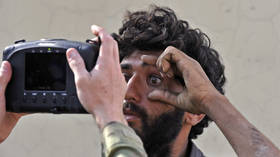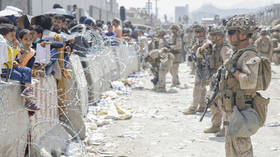People are horrified the Taliban seized biometric devices, but the real scandal is the extent of US military data collection

A huge amount of opprobrium was heaped on the Americans for allowing this sensitive data to fall ‘into the wrong hands’. However, surely a better question is why had they gathered all this deeply personal data in the first place?
It’s been reported that the Taliban has seized US military biometric devices in the wake of Washington’s flight from Afghanistan, which could put civilians who assisted coalition forces at significant risk.
The devices, known as HIIDE, for Handheld Interagency Identity Detection Equipment, contain identifying biometric data such as iris scans and fingerprints, as well as biographical information – while their primary stated purpose is to track insurgents, biometric data was also collected and stored on Afghans who assisted the US occupation forces.
The story sparked outcry, widely invoked by both opponents and advocates of the 20-year war as yet another deplorable example of Washington leaving its allies high and dry. While it seems clear there was no consideration given to what could happen if the technology fell into the ‘wrong’ hands, critics have nonetheless overwhelmingly failed to consider the terrifying ramifications of this data being in the right hands, and how the US came into possession of it in the first place.
When precisely the practice of collecting Afghans’ biometric data began isn’t certain, although at a 2010 conference in Kabul, US military officials laid out the terms of Afghan 1,000, a program which sought to collate information on 80% of the country’s population, around 25 million people. It was framed in extremely positive terms, not merely as a means to identify terrorists and criminals, but “enable progress in society” due to its “countless applications for the provision of services” to citizens.
It’s uncertain if that target was reached before Washington’s withdrawal, but the strategy remained in operation for over a decade. The next year, it was reported that Washington ultimately sought to gather biometric data on all living Afghans.
To achieve the lofty goal, a policy of mandatory data collection was imposed for every traveler entering the country via any means, and a dedicated Population Registration Department was created, with offices throughout the country. Even foreign journalists covering the war were fingerprinted, and their irises scanned. Moreover, occupation forces conducted innumerable “enrolment missions”, entering towns and villages and forcing locals to hand over their biometric data at literal gunpoint.
Also on rt.com If Biden worried less about the optics of communicating with the Taliban, the IS-K carnage may not have happenedA US Army guide states emphatically that “all combat outposts and checkpoints throughout Afghanistan make it a priority to collect biometric data from as many local nationals as possible.” In the aftermath of a bombing or skirmish, soldiers are told to “enroll everyone”, including the dead, their DNA to be collected using buccal swabs to capture cells lining the mouth. The “payoff” for coalition forces was said to be so great, “commanders must be creative and persistent in their efforts to enroll as many Afghans as possible.”
In a section disturbingly titled “Population Management”, the guide recommends that everyone who lives within an operational area “should be identified and fully biometrically enrolled with facial photos, iris scans, and all ten fingerprints (if present).” Soldiers must also record “good contextual data” about individuals, such as “where they live, what they do, and to which tribe or clan they belong.” Citizens were to be told the collection protected them from potentially violent elements and troublemakers.
A lengthy article in the January 2014 edition of Military journal Joint Forces Quarterly offers a glowing appraisal of the “biometric-enabled intelligence” system rolled out in Kabul, declaring it to be a “key enabling factor” in US counterinsurgency efforts, and “an invaluable part of the campaign that has even greater potential in the future.” It documents how enrolment was often carried out using colorful trucks with jingling bells, in the manner of an ice cream van, in order to make the process “more culturally appealing” – particularly in respect of children, presumably.
Also included are several alleged “success stories”, such as one instance in which two Afghan police officers, neither of whom could read or write, spotted an individual on a “biometrically developed insurgent watch list” approaching their checkpoint.
One of the officers is said to have taken the man – identified as having been involved in “multiple IED events” – into custody “with a broad smile,” and the anecdote ends on an upbeat note, hailing how the officers’ illiteracy was no barrier to them removing a dangerous insurgent from the battlefield due to the miracle of biometric intelligence. Cheery stuff, although journalist Annie Jacobsen has exposed in chilling detail just how fallible biometric evidence can be.
Also on rt.com NYPD spent $159mn on facial recognition, ‘stingray’ cellphone trackers & X-ray van spy tools using secretive fund, documents showIn July 2012, US Army First Lieutenant Clint Lorance ordered his platoon to shoot three unarmed motorcycle riders in Kandahar province. The next year, a court martial found him guilty of two counts of second-degree murder, attempted murder, wrongfully communicating a threat, reckless endangerment, soliciting a false statement, and obstructing justice, sentencing him to 20 years in prison. However, in November 2019, he received a pardon from Donald Trump.
The then-president released Lorance after he was shown fingerprints and DNA data that purportedly indicated the Afghan men killed were Taliban bomb makers, not civilians. However, after some determined digging, Jacobsen found that one set of fingerprints allegedly found on an exploded IED said to prove one of the dead men was a bomber actually belonged to a police officer, who was likely to have contaminated the evidence in the line of duty. The other set did indeed belong to a bomber – who was still alive.
Lorance isn’t an isolated example either. Staff Sergeant Robert Bales is serving life for killing 16 Afghan villagers in cold blood in March 2012. While he pleaded guilty to the charges and admitted his tours of Afghanistan and Iraq had instilled a loathing of the local population within him, he’s now appealing his sentence. The case rests on data provided by a biometrics expert who also worked on the Lorance case, which he claims proves witnesses to Bales’ crimes were Taliban bomb makers who left their fingerprints on bomb components.
Evidently though, Afghanistan was just an experiment – and Washington was enamored with the results. The White House’s proposed Army budget for 2022 seeks over $11 million to purchase 95 new biometric collection devices, meaning the policy will almost inevitably be rolled out again in whichever country is next in the US crosshairs.
Also on rt.com ‘Our allies don’t trust us, our enemies are emboldened’ – vet who survived Kabul bombing on US disastrous failure in AfghanistanWhere that will be is unknown, but there’s also the question of what implications the Afghan test run has for the Western world. Governments, police forces, security services and even big business are increasingly using cutting-edge technology to amass, store and analyze vast reams of sensitive personal data – much of it was similarly trialed during the War on Terror, and sold to home audiences on the basis of convenience and security, just as the military’s biometric data harvest was sold to Afghans. Now the troops are finally home, has the fight been brought back with them?
Think your friends would be interested? Share this story!
The statements, views and opinions expressed in this column are solely those of the author and do not necessarily represent those of RT.













